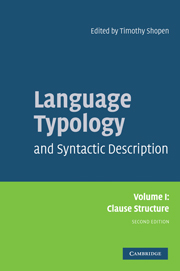Book contents
- Frontmatter
- Contents
- List of figures
- List of tables
- List of contributors
- Acknowledgements
- List of abbreviations and symbols
- 1 Parts-of-speech systems
- 2 Word order
- 3 The major functions of the noun phrase
- 4 Clause types
- 5 Speech act distinctions in grammar
- 6 Passive in the world's languages
- 7 A typology of information packaging in the clause
- Bibliography
- Subject index
3 - The major functions of the noun phrase
Published online by Cambridge University Press: 16 January 2010
- Frontmatter
- Contents
- List of figures
- List of tables
- List of contributors
- Acknowledgements
- List of abbreviations and symbols
- 1 Parts-of-speech systems
- 2 Word order
- 3 The major functions of the noun phrase
- 4 Clause types
- 5 Speech act distinctions in grammar
- 6 Passive in the world's languages
- 7 A typology of information packaging in the clause
- Bibliography
- Subject index
Summary
Introduction
In this chapter we will discuss the major functions of noun phrases (NPS) in the languages of the world. We can think of nps as having three different kinds of functions: semantic, pragmatic and grammatical. Semantic and pragmatic functions are aspects of the meanings of sentences, grammatical functions aspects of their structure.
Semantic functions, often called semantic roles, are the different ways in which a sentence can describe an entity as participating in a situation. Consider (1):
(1) The farmer kills the duckling
Here the verb kill indicates that we have a situation in which one entity kills another. It provides two semantic roles, ‘killer’ and ‘killed’, taken by the referents of the preverbal NP the farmer and the postverbal NP the duckling, respectively. In order for the sentence to be true, the entities referred to by these NPS must act or be acted upon in accord with these roles. Semantic roles are thus an aspect of the relation between sentences and the situations they refer to.
But language is used not merely to depict the world, but to communicate in it: its users are part of the world they talk about. There is therefore a further aspect of meaning, concerning more than than just what a sentence is about, which contributes to determining when it may be used.
- Type
- Chapter
- Information
- Language Typology and Syntactic Description , pp. 132 - 223Publisher: Cambridge University PressPrint publication year: 2007
- 41
- Cited by

